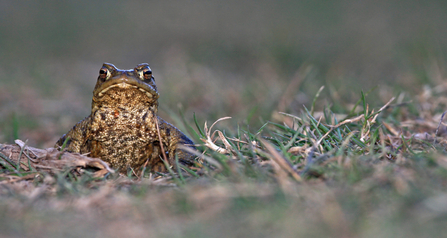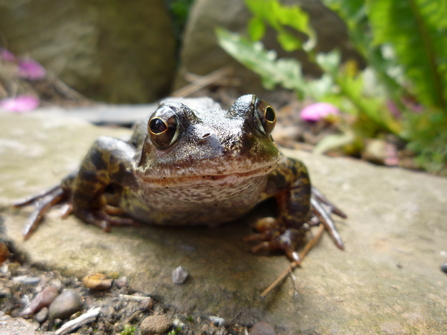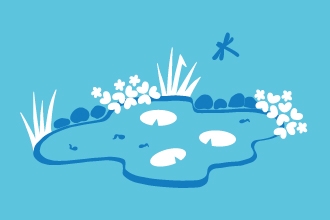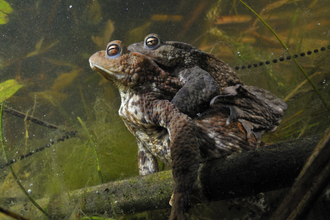As winter fades into spring, when will our amphibian friends wake up? It's rarely exactly the same time each year as it can depend so much on the weather. However, when the temperature is right, the days are growing longer, ponds are smelling ‘perfect’ (to a frog or toad’s nose, that is) and the moon is nearly full, migration begins!
Amorous amphibians
Common toad by Jason Curtis

Common toad by Wendy Carter
Toads are our more discerning amphibian parents. More than 80% of toads migrate to their natal pond - the one they were born in; they may even pass by other suitable ponds on their journey ‘home’. Toads are pickier about their choice of breeding ground than frogs, preferring more established and deeper bodies of water. Frogs, on the other hand, are quite happy to breed in more ephemeral ponds - I've even seen frogspawn in wheel ruts. Sadly, many ponds have been filled in and lost so not only do our croaking friends have to travel further but they often have to deal with the danger of roads.
Enter the toad patrollers. There are hundreds of us throughout the UK, wearing high-vis jackets and moving toads from one side of a road to the other, helping them on their way to ponds and breeding success. We count how many toads, frogs and newts we rescue (and how many we unfortunately don’t get there in time for) and submit our results to the charity Froglife's, who co-ordinate the Toads on Roads campaign and our volunteering efforts. I'm the patrol manager for four small rural crossings and we usually rescue around 470 toads, frogs and newts each year. We're small fry compared to one or two crossings in other counties that are so large entire roads are closed for them.

Common frog by Stu Brown
Our crawling and hopping friends spend remarkably little time in ponds, at least compared to what most people believe. Outside of the main breeding season in early spring, you’re more likely to find a toad under a clump of earth or a frog hiding away in a pile of logs. Toads can spend their winter slumbers more than a mile away from their breeding pond; imagine being that small and needing to wander back through long grass, dense scrub and fast roads! They spend winter in a state of torpor, which is an amphibian equivalent to hibernation, safely tucked up amongst the roots of trees, in log piles or under large tussocks of grass.
Before helping toads to cross the road, we need to check a map to see where the ponds are that they’re aiming for. But how do we know what we’re moving? Toads crawl rather than hop like a frog. They have a brown and bumpy skin whereas frogs are more variable in colour (often mottled) and have a circular depression behind their eye.

Frogspawn and toadspawn by Wendy Carter
The females lay around 2000 eggs each because most won’t survive to adulthood – there are many predators that find tadpoles rather tasty! If you have a pond full of spawn, you won’t be over-run with frogs or toads. If the spawn is laid in clumps it’s frogspawn and if you see that it’s laid in strings, you’ve got toads too.
We're trying to map the location of toads and frogs as well as the timing of the arrival of spawn across the county. If you see toads, frogs or their spawn, please take a pic and upload your image (or video) via our short Wildlife Sightings form. If you'd like to lend a hand at your local toad crossing or think you might need to register a crossing, take a look at Froglife's Toads on Roads campaign.



